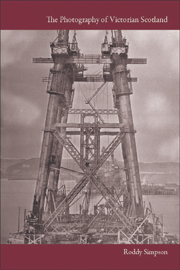Book contents
- Frontmatter
- Contents
- List of Figures
- Introduction
- 1 The Origins of Scottish Photography: Pioneering Activities in St Andrews and Edinburgh
- 2 David Octavius Hill and Robert Adamson: the ‘Partnership of Genius’ and the First Art Photography
- 3 Photography for the Few: The Activities of the Enthusiastic and Artistic Amateurs
- 4 Photography in Demand: The Work of the Increasing Number of Professional Photographers to Meet Public Demand
- 5 Scots Abroad: The Achievements of Scottish Photographers Around the World
- 6 Tourists and Travellers: Images of Scotland Produced for the Rapidly Growing Tourist Market and Photographs Taken by Visitors
- 7 Recording Social Conditions and Industrial Change: Photographs of what was Being Lost and what was Replacing it
- 8 Photography as Art: Looking at the Images and the Arguments
- 9 Populist Activity and Pictorialism: Popular Involvement with Cheap and Mass Produced Cameras and Photographers with Artistic Aspirations
- 10 Scotland's Enduring Photographic Legacy
- Bibliography
- Acknowledgements
- Index
2 - David Octavius Hill and Robert Adamson: the ‘Partnership of Genius’ and the First Art Photography
Published online by Cambridge University Press: 05 August 2013
- Frontmatter
- Contents
- List of Figures
- Introduction
- 1 The Origins of Scottish Photography: Pioneering Activities in St Andrews and Edinburgh
- 2 David Octavius Hill and Robert Adamson: the ‘Partnership of Genius’ and the First Art Photography
- 3 Photography for the Few: The Activities of the Enthusiastic and Artistic Amateurs
- 4 Photography in Demand: The Work of the Increasing Number of Professional Photographers to Meet Public Demand
- 5 Scots Abroad: The Achievements of Scottish Photographers Around the World
- 6 Tourists and Travellers: Images of Scotland Produced for the Rapidly Growing Tourist Market and Photographs Taken by Visitors
- 7 Recording Social Conditions and Industrial Change: Photographs of what was Being Lost and what was Replacing it
- 8 Photography as Art: Looking at the Images and the Arguments
- 9 Populist Activity and Pictorialism: Popular Involvement with Cheap and Mass Produced Cameras and Photographers with Artistic Aspirations
- 10 Scotland's Enduring Photographic Legacy
- Bibliography
- Acknowledgements
- Index
Summary
The Scots wholeheartedly embraced photography and mastered the technical challenges it presented but it was the partnership of David Octavius Hill (1802-70) and Robert Adamson (1821-48), formed a few years after the invention of photography, that was to take the medium to a new level, with the application of unsurpassed artistic creativity.
Their status in photography is emphatically confirmed by the photo-historians Helmut and Alison Gernsheim who wrote:
D. O. Hill and Robert Adamson are universally accorded first place in the annals of photography. The artistic spirit with which their photographs are imbued has impressed all succeeding generations, and it is indeed astonishing that in its very first years the new art should have reached its highest peak in the magnificent achievements of these two Scottish photographers.
Robert Adamson with his camera and D. O. Hill with his sketchpad (Figure 2.1) are shown in Hill's painting titled The First General Assembly of the Free Church of Scotland, Signing the Act of Separation and Deed of Demission at Tanfield, Edinburgh, 23 May 1843. The painting not only has a large title but it measures about 12 feet × 4 feet 8 inches (360 × 140 cm) and hangs in the offices of the Free Church of Scotland at the Mound, Edinburgh. It is normally referred to as the Disruption painting and, as will be explained shortly, this painting was the reason Hill and Adamson started to work together.
- Type
- Chapter
- Information
- The Photography of Victorian Scotland , pp. 21 - 46Publisher: Edinburgh University PressPrint publication year: 2012



